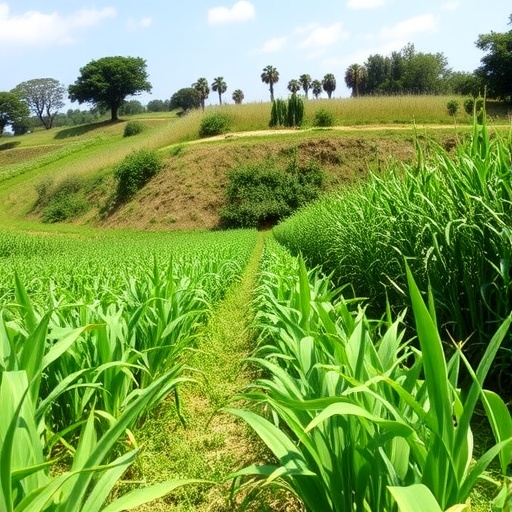In the rugged, dry, and sloping farmlands of southern China, the cultivation of sugarcane—a crop integral to both economic stability and regional agriculture—faces a persistent and multifaceted challenge: soil degradation. For decades, the interplay of natural topography and entrenched monocropping practices has accelerated the deterioration of soil quality. Issues such as intensified erosion, imbalanced nutrient profiles, and dwindling microbial diversity complicate efforts to maintain sustainable yields. This alarming ecological scenario not only threatens the viability of sugarcane production but also calls for innovative strategies to restore soil health while safeguarding agricultural productivity.
Addressing this critical issue, a recent comprehensive review conducted by Guoqin Huang of Jiangxi Agricultural University, alongside Kai Huang from Guangxi Hydraulic Research Institute, sheds new light on the transformative potential of intercropping systems in sugarcane agriculture. Their work, published in the journal Frontiers of Agricultural Science and Engineering, delves deeply into how the integration of multiple crops within sugarcane fields can catalyze a series of beneficial soil processes. The synthesis of empirical studies and regional case analyses presents a forward-looking paradigm for ecological restoration in these fragile environments.
Traditional sugarcane farming in southern China predominantly relies on monocultures, where a single genotype is cultivated extensively. While efficient for short-term productivity, such methods often culminate in detrimental soil phenomena including compaction, nutrient leaching, and reduced organic matter. In contrast, intercropping—where two or more crop species coexist spatially and temporally—introduces biological complexity that can counteract these deficiencies. This polyculture strategy acts synergistically upon the soil ecosystem, fostering an environment conducive to enhanced fertility and structural integrity.
One key mechanism by which intercropping improves soil health is through root system complementarity. Distinct crops explore different soil strata with their root networks, disrupting compacted layers and enhancing soil porosity. This vertical niche differentiation allows for more effective water infiltration and air exchange, promoting robust root growth and microbial habitat expansion. Consequently, the soil’s physical architecture becomes more favorable for sustained plant development and nutrient cycling.
Nutrient complementarity offers another pivotal advantage in these intercropping systems. Leguminous crops, such as soybeans, engage in symbiotic nitrogen fixation through their interaction with rhizobia bacteria, converting atmospheric nitrogen into bioavailable forms without synthetic inputs. When intercropped with sugarcane, these legumes provide a natural fertilization effect, reducing reliance on chemical nitrogen fertilizers. Furthermore, companion crops like maize and various vegetables exhibit differing nutrient acquisition patterns, thereby minimizing nutrient overlap and competition, which optimizes the utilization of macro- and micronutrients within the soil matrix.
In addition to physical and chemical enhancements, intercropping profoundly influences soil biological communities. The diversity of root exudates and decomposed plant residues creates a rich array of substrates that stimulate microbial proliferation and diversity. Beneficial microorganisms, including bacteria and fungi, thrive under these conditions, facilitating nutrient mineralization, disease suppression, and improved soil resilience. This microbial enrichment underpins a dynamic and interactive soil food web critical for maintaining long-term fertility.
Empirical evidence from southern China highlights the evolution of sugarcane intercropping practices beyond rudimentary mixtures. One notable innovation is the “sugarcane–soybean” wide-narrow row planting model adopted in Guangxi province. This system skillfully leverages spatial light distribution, with soybeans occupying wider rows to maximize photosynthetic efficiency while supporting nitrogen enrichment. The integration promotes not only enhanced crop growth but also sustainable land use by recycling organic matter and preserving soil carbon pools.
The success of intercropping, however, is contingent upon meticulous agronomic management. Simply planting multiple crops in proximity is insufficient and may even exacerbate competition for critical resources such as light, water, and nutrients. Fine-tuning parameters such as row spacing, crop ratios, and varietal compatibility ensures that each species can grow optimally alongside others. Synchronizing growth cycles and avoiding overlap in peak nutrient demands are equally crucial to harmonize crop development and maximize system productivity.
Despite the promising outlook, the adoption of intercropping strategies remains constrained by several challenges. Mechanization poses a significant barrier—existing agricultural machinery, often designed for monocultures, is ill-suited to the spatial heterogeneity of intercropped fields, particularly in the hilly and sloping landscapes characteristic of southern China. There is an urgent need for the development of adaptable, small-scale mechanized solutions that accommodate diverse planting patterns without compromising efficiency.
Moreover, the absence of comprehensive regional databases hinders the optimization of crop combinations tailored to specific climatic and edaphic conditions. Each locality presents unique challenges related to soil type, moisture availability, pest pressure, and temperature regimes. A repository of scientifically vetted intercropping models could guide farmers and extension services towards best practices that align with local environments, thereby enhancing the scalability and success of these systems.
Policy frameworks must also evolve to foster wider acceptance and implementation. Presently, insufficient subsidies, limited technical training, and lack of awareness curtail farmer participation. Strengthening institutional support through targeted incentives, capacity-building programs, and knowledge dissemination will empower agricultural stakeholders to transition from conventional monocultures to diversified cropping systems that safeguard soil health and productivity.
This pioneering research by Huang and colleagues not only maps a path forward for sustainable sugarcane agriculture but also contributes broadly to global conversations on agroecosystem resilience. As climate change and land degradation intensify, integrating ecological principles into farm management is imperative. Intercropping emerges as a versatile, scientifically grounded approach that reconciles productivity with environmental stewardship.
In conclusion, the comprehensive review elucidates the multifaceted benefits of sugarcane intercropping as a viable strategy for enhancing soil fertility in the dry, sloping regions of southern China. Through root architecture diversification, nutrient cycling optimization, and microbial community enrichment, intercropping transcends conventional agriculture to usher in a regenerative paradigm. Addressing mechanization, knowledge dissemination, and policy support challenges will be instrumental in mainstreaming this approach, ensuring food security and ecological integrity for future generations.
Article Title: Optimizing soil fertility in southern China: a review of sugarcane intercropping strategies
News Publication Date: 15-Sep-2025
Web References:
https://journal.hep.com.cn/fase/EN/10.15302/J-FASE-2025612
Image Credits: Wenlong ZHANG, Jinhua SHAO, Kai HUANG, Limin CHEN, Guanghui NIU, Benhui WEI, Guoqin HUANG
Keywords: Agriculture, applied sciences, soil fertility, sugarcane, intercropping, sustainable agriculture, soil degradation, nutrient cycling, microbial diversity, ecological restoration




